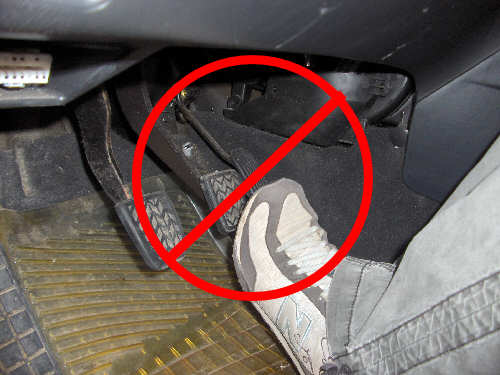
This post is part of a series on basic hypermiling techniques, intended to expound upon a more basic description in order to make them more accessible as well as put them in the context of safety and practicality.
Driving without brakes (DWB) always makes me think of some run away roller coaster ride. You know, children screaming for their lives and all that good stuff. However, it is actually a very useful technique that can save you a lot of fuel in heavier highway traffic and in the city. This technique overlaps with a lot of other techniques which won’t all be mentioned here.
The whole idea is generally to conserve momentum, momentum you have built up by burning gas. For example, you burn gas to get up to 60 miles per hour. Then traffic slows down suddenly and you use your brakes to slow to 40 mph. Shortly after, traffic speeds up again so you accelerate back up to 60 again. How many times does this happen in your daily commute? Well, what if you only had to accelerate up to 60 once? You would have saved the gas used to go from 40 back up to 60. This is an example of what DWB does for you.
What would you do in this case if you were driving without brakes? Well, first you would leave a good cushion of space between you and the driver in front of you. Next, you would watch well ahead of the car in front of you. When you see brake lights from a few (or more) cars ahead you let off the gas and coast. Ideally, by the time you catch up to the car ahead of you they should already be accelerating again and you shouldn’t have to use your brakes at all. If you find yourself still braking a lot, increase the following distance to give yourself a bigger cushion.
The same thing applies for city driving. Watch the lights and try not to use your brakes. Slowing down is pretty much inevitable, but minimizing brake use can greatly increase your gas mileage.
The point is, if you know your going to have to slow down at any point, stop accelerating as soon as possible and start coasting. By using the brakes you are wasting gas – you’re effectively turning it into brake dust.
This may sound like common sense, but so many drivers neglect to do this day in and day out. Just think about how much gas is wasted when you see brake lights going to work tomorrow. It’s amazing how much fuel could be saved with this technique alone.
If you liked this post, sign up for out RSS Feed for automatic updates.
Popularity: 7% [?]




{ 7 comments }
Good article. Driving without brakes also makes a driver pay good attention to what is happening up front and also behind you. Resulting in better safer drivers.
I have always been amazed to see freeway drivers totally unaware, until the last minute, that they are about to rear-end the car in front of them, causing a need for heavy braking and the potential for multiple pile-ups.
One item you missed was traffic lights versus traffic circles.
The US always uses traffic lights as the default design at a road intersection. In Europe, the default design is a circle.
A traffic light mandates that 90% of the time you have to stop at an intersection. At a European traffic circle (properly designed and with right of way understood by all) you get through the circle without stopping 90% of the time. This results in significant energy and pollution savings.
Nice article. This started me to wonder why not convert this break energy to some form of static energy (battery, spring…) , store and release it back when we need to accelerate again. I know few hybrids convert them to battery power, but how about for non-hybrids?
Sri, even a mechanical storage of some sort would still be considered a hybrid. On that note, there are a few companies out there trying to do exactly as you have asked. I’ve heard of a range of ideas from storing power in a flywheel, battery, powering the alternator with braking power and a few more that I can’t remember off the top of my head. Its definitly being looked into as manufacturers are finally seeing the huge benefits that hybrids can provide.
Of course, a limitation to the technique arises when driving during rush hour through the El Toro Y in Southern California where every driver around you seems to cuts you off as you coast because they want to fill even the smallest space between you and the car ahead with themselves (thus causing even more stop and go traffic for everybody behind you).
Thanks the author!
Using the brakes as little as possible certainly has advantages for fuel economy and traffic security – you habe to plan your driving more carefully. I’ve done this for quite a few years in Sweden and it certainly improves mileage. But there is a tremendous downside to it, at least if you drive in a climate with a lot of rain, snow and thawing salt on the roads: the brake discs rust, the brake pads wear the discs unevenly, and eventually only part of the disc is used by the pads. A 50% reduction is disc use in not uncommon!. The result is that you first loose the possibility to brake efficiently in emergency situations, and secondly, you needs to change the brake discs AND pads long before you normally would have to. This is quite expensive, and not very economic to the ecology. The problem is quite common in Scandinavia.
If you are into “driving without brakes”, make sure you inspect your brake discs every month – the process of uneven wear is fast and can be irreversible in 3-4 months. The rear brake discs are usually affected first. At the first signs of uneven wear you should start using your brakes more often.
I’m unclear why, whether in the city or the highway, drivers leave so little space between themselves and the car in front. Besides saving a little gas, leaving a little room just makes driving easier for everyone. And I don’t think using the gas and brake to keep yourself as close to the car in front of you as possible gets anyone anywhere any quicker.
But, that’s how people drive. And, for suckers like me who don’t tailgate, the empty space in front of my car is an invitation for other drivers to move a car length ahead.
Comments on this entry are closed.